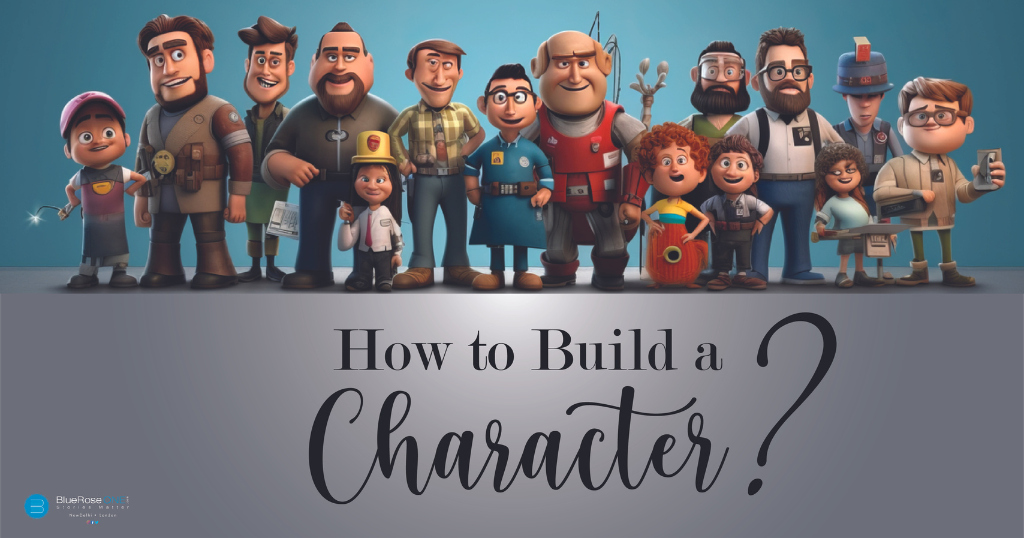In a world where reality is fictionized to make up for the lack of resonance, characters are made to be our comfort zones. In a book, a character is a fictional person, being, or entity created by the author to play a role within the story. Characters are central to the narrative and are typically individuals with their own personalities, backgrounds, motivations, and complexities.
They can be protagonists, antagonists, supporting characters, or even minor characters, each serving a specific function in advancing the plot, conveying themes, or providing depth and context to the story.
A well-developed character is not just a name and a physical description; it is a multi-dimensional entity with emotions, desires, flaws, and a unique voice. Readers or viewers engage with these characters, forming connections and emotional attachments as they follow the characters’ journeys and growth throughout the book.
Read: How to Beautify Your Book’s Back Cover Design: A Step-by-Step Guide
The portrayal and development of characters play a pivotal role in making a story relatable and compelling to the audience. There are many characters who have become our favourites, whether they are the main leads or supporting characters. But why and how does that happen? Why do we connect with them? Why do we feel what they feel?
It is pretty simple. Because they are written so well and enigmatically, they draw us towards them. In this blog post, we will be going in depth as writers and readers as to how a character is built to be a fan’s favourite.
Protagonist: Zero until the writers make them heroes.
The protagonist is the central character around whom the story revolves. The protagonist is typically the character whose journey, challenges, and growth the narrative primarily focuses on. They are often the characters with whom the reader or audience is meant to identify or empathize. The protagonist is at the forefront of the story’s action and is usually involved in the major conflicts or dilemmas that drive the plot forward.
The role of the protagonist can vary from one story to another. In some cases, the protagonist is a hero or a character with admirable qualities, while in others, the protagonist may be more complex, with both strengths and flaws. Protagonists can come in various forms, including heroes, anti-heroes, and everyday individuals. Their character development and their journey through the story are central to the overall narrative structure.
Developing a protagonist’s character to be realistic and relatable is a cornerstone of crafting a compelling narrative. To achieve this, it’s imperative to create a character with depth and complexity. A one-dimensional, flawless protagonist can alienate readers, as they may struggle to identify with such perfection. Instead, imbue your main character with a rich backstory that informs their present actions and motivations.
Read: How to pick between Paperback, Hardcover, eBook – What’s best for you?
Explore their strengths and weaknesses, ensuring that their flaws are as apparent as their virtues. These imperfections make characters more relatable and human. Clearly define your protagonist’s motivations and goals, as these desires are what drive the plot forward. The protagonist should undergo both internal and external conflicts, wrestle with moral dilemmas, and experience moments of self-doubt.
Crafting a well-thought-out character arc is essential, showcasing their evolution throughout the story. By allowing your protagonist to grow and change in response to their experiences, you invite readers to join them on a journey of self-discovery and transformation. Infuse the character with a unique voice, use dialogue and interactions to reveal their personality, and remember to “show, don’t tell.”
Ultimately, relatability comes from the protagonist’s humanity, vulnerabilities, and the authenticity of their struggles. It’s this relatability that forges a strong connection between the character and the reader, ensuring their immersion in the narrative.
Antagonist: Readers’ Guilty Pleasure and Writers’ Dark Side
The antagonist is a character or force that opposes the protagonist, creating conflict and tension within the story. The antagonist serves as the primary source of opposition and stands in the way of the protagonist’s goals or desires. They are often responsible for creating obstacles, challenges, and dilemmas that the protagonist must overcome, driving the plot forward and providing a central source of conflict.
Antagonists come in various forms and can be complex characters with their own motivations, or they can be more one-dimensional figures whose primary purpose is to act as an obstacle to the protagonist’s journey. Some antagonists may be villains, but not all antagonists are necessarily evil or malevolent; they simply have goals or interests that conflict with those of the protagonist.
The role of the antagonist is essential in shaping the narrative and helping to reveal the strengths and weaknesses of the protagonist. The tension and conflict generated by the antagonist are central to the story’s progression and often lead to character development and growth in the protagonist.
Developing a realistic and relatable antagonist is a pivotal aspect of crafting a dynamic and engaging narrative. To achieve this, it is essential to delve deep into the character’s psyche. Start by defining their motivations and goals clearly, providing insight into what drives them. Avoid the clichéd, one-dimensional villain and opt for complexity, crafting a backstory that elucidates their evolution and choices. Develop a moral code that, while differing from the protagonist’s, remains consistent within their worldview, thus presenting moral dilemmas.
Like the hero, the antagonist should possess flaws and vulnerabilities, rendering them human and relatable. It’s often these imperfections that generate empathy. Incorporate moments that allow readers to connect with the antagonist, showcasing their struggles and vulnerabilities. Consider granting the antagonist a character arc, offering opportunities for change and growth, and exploring their relationships with other characters.
Reveal a range of emotions, from doubt to regret, and imbue them with humanising qualities, be they a sense of humour or moments of genuine care. In dialogue and monologues, provide insights into their mindset, always adhering to the “show, don’t tell” principle. Ultimately, creating an antagonist with depth and relatability adds layers to your story, making it more engaging and thought-provoking for your audience.
Publish your book with BlueRoseONE and become a bestselling author. Don’t let your dream of becoming an author fade away, grab the opportunity now and publish your book – be it fiction, non fiction, poetry or more.
You may also like: 7 Top Rated Self-Help Books of all time in 2024
Supporting Characters: The Fun Bobby of Literature
Supporting characters are characters who play significant roles in the story but are secondary to the main characters, such as the protagonist and the antagonist. While they may not be the central focus of the narrative, supporting characters often have their own distinct personalities, motivations, and storylines that contribute to the overall plot and character development. These characters provide depth and context and often serve various functions within the story, including offering insight into the main characters, advancing subplots, and providing necessary relationships and dynamics.
Supporting characters come in a variety of forms, such as friends, family members, mentors, sidekicks, love interests, or even minor characters who have brief but essential interactions with the main characters. They add complexity to the story, create opportunities for conflict and growth, and help to make the fictional world more immersive and relatable to the reader. While these characters may not be at the forefront, like the protagonist or antagonist, they play pivotal roles in the story’s development and often provide insights into the main characters.
To achieve this, it’s essential to imbue supporting characters with distinct personalities, roles, and motivations. Each one should have a backstory that informs their actions and desires, and they should uniquely contribute to the narrative. Explore the complex relationships between supporting characters and the main characters, as these dynamics can reveal different facets of their personalities and motivations.
While supporting characters may not undergo as pronounced character arcs as the protagonist, consider allowing them some growth or change to make them more compelling. Including moments of vulnerability or personal challenges can evoke empathy from the audience, making these characters more relatable. Utilise dialogue and interactions to showcase their unique qualities and roles, and remember the “show, don’t tell” principle. By following these steps, supporting characters become integral to the story’s development, contributing depth and relatability to the narrative and enriching the overall storytelling experience.

Best Ways to Build a Character - Evolve & create your story now.
Developing different types of characters in a story requires a deep understanding of their role, purpose, and characteristics within the narrative.
Here’s how to develop each type of character:
Static Characters:
Clearly define their unchanging traits, beliefs, or behaviours.
Showcase their consistent nature by having them react predictably to various situations.
Use static characters to provide stability or serve as a source of conflict in the story.
Dynamic Characters:
Establish their initial traits and flaws that need addressing.
Create a catalyst for change, such as a significant event or interaction.
Show their evolution through internal reflections, external actions, and evolving relationships.
Ensure the transformation aligns with the story’s themes and message.
Round Characters:
Develop a well-rounded backstory with personal history, motivations, and secrets.
Give them complex emotions, contradictions, and internal conflicts.
Present them with moral dilemmas or situations that reveal their multifaceted nature.
Allow them to grow, change, or adapt, even if they don’t undergo a complete transformation.
Flat Characters:
Keep their traits simple and one-dimensional, focusing on their specific role in the plot.
Use flat characters for minor or supporting roles that don’t require depth.
Ensure their actions or characteristics serve a specific purpose in advancing the storyline or highlighting other characters.
Stock Characters:
Embrace the archetypal qualities associated with these characters.
Add unique, memorable details or quirks to make them stand out.
Utilise stock characters to fulfil expected roles while occasionally subverting expectations to add depth or humour.
Foil Characters:
Identify the traits or qualities you want to contrast with the protagonist.
Highlight these differences through interactions, dialogue, or character development.
Foil characters can be used to emphasise the strengths and weaknesses of the main character and contribute to their growth.
Symbolic Characters:
Clearly establish the abstract concept or idea they represent.
Use their actions, appearance, or dialogue to symbolise the concept throughout the story.
Ensure their presence reinforces the story’s themes and message related to the symbol.
Read: A Complete Guide on How to Make Your Book an International Bestseller
Remember that well-developed characters enhance the depth and authenticity of your story. Regardless of their type, every character should have a purpose and contribute to the overall narrative. Tailor their development to suit the story’s goals and themes, and create a diverse cast that engages readers on multiple levels.
Characters, whether protagonists, antagonists, or supporting roles, are not mere words on a page. They are conduits for readers to embark on emotional journeys. In their complexities, we see reflections of our own humanity, our struggles, our growth, and our capacity to empathise with those who may exist only in the realm of fiction.
The art of character development is the art of making the unreal real, and in doing so, they become our confidants, our inspirations, and our cherished favourites. We connect with them because they remind us of the profound, intricate nature of our own existence, and through their stories, we find a piece of ourselves.
Publish your book with BlueRoseONE and become a bestselling author. Don’t let your dream of becoming an author fade away, grab the opportunity now and publish your book – be it fiction, non fiction, poetry or more.
















